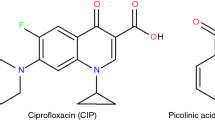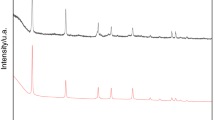Abstract
The grinding techniques were used in different pharmacotechnical process. The control of the effect of grinding in solid state properties of drugs is very important, mainly in hydrated drugs. Levofloxacin hemihydrate (LVF) is a good example of this type of compounds and a broad spectrum antibiotic of the fluoroquinolone drug class. The samples of LVF with and without grinding were studied using different characterization techniques such as thermogravimetry, differential scanning calorimetry, fourier-transformed infrared, X-ray powder diffraction, and hot stage microscopy. The purpose of the present study was to evaluate the effects of grinding in the dehydration and rehydration processes in levofloxacin hemihydrate. After heating, the samples lost water molecules and the rehydration process was modified depending on defects due to the grinding. At room temperature, the complete transformation to the hemihydrate form was detected only for the sample without grinding. On the other hand, the milled sample showed two phases, hydrate and anhydrate forms. Therefore, the defects in the crystalline structure would cause the irreversible transformation.









Similar content being viewed by others
References
Bernstein J. Polymorphism in molecular crystals. 14th ed. Oxford: IUCr, Oxford; 2013.
Vippagunta SR, Brittain HG, Grants DJW. Crystalline solids. Adv Drug Deliv Rev. 2001;48:3–26.
Jeffery GA. Water structure in organic hydrates. Acc Chem Res. 1969;2:344–52.
Khankari RK, Grant DJW. Pharmaceutical hydrates. Thermochim Acta. 1995;248:61–79.
Brittain HG. Polymorphism in pharmaceutical solids. In: Morris KR, editor. Structural aspects of hydrates and solvates. Milford: Discovery Laboratories, Inc; 2006.
Nelson JM, Chiller TM, Powers JH, Angulo FJ. Fluoroquinolone-resistant Campylobacter species and the withdrawal of fluoroquinolones from use in poultry: a public health success story. Clin Infect Dis. 2007;7:977–80.
Kitaoka H, Wada C, Moroi R, Hakusui H. Effect of dehydration on the formation of levofloxacin pseudopolymorphs. Chem Pharm Bull. 1995;43(4):649–53.
Reddy MS, Eswaraiah S, Reddy KR, Reddy SR, Prakash PJ. Novel anhydrous crystalline form of levofloxacin and process for preparation there of levofloxacin. United States Patent Application Publication, US 2004/0152701 A1, 2004.
Acknowledgements
The authors acknowledge the Coordenação de Aperfeiçoamento de Pessoal de Nível Superior (CAPES) for the financial support, Pós-graduação em Farmácia (PGFAR—UFSC) and Pró-reitoria de Pós-graduação (PRPG). The XRPD measurements were carried out at Laboratório de Difração de Raios-X of Universidade Federal de Santa Catarina.
Author information
Authors and Affiliations
Corresponding author
Rights and permissions
About this article
Cite this article
Pereira, R.N., Fandaruff, C., Riekes, M.K. et al. Grinding effect on levofloxacin hemihydrate. J Therm Anal Calorim 119, 989–994 (2015). https://doi.org/10.1007/s10973-014-4233-1
Received:
Accepted:
Published:
Issue Date:
DOI: https://doi.org/10.1007/s10973-014-4233-1




